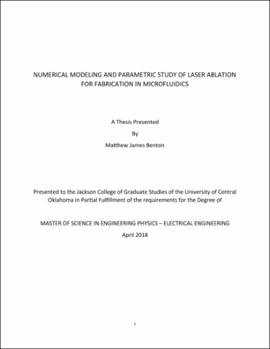| dc.contributor.advisor | Hossan, Mohammad | |
| dc.contributor.author | Benton, Matthew James | |
| dc.date.accessioned | 2020-07-09T14:41:09Z | |
| dc.date.available | 2020-07-09T14:41:09Z | |
| dc.date.issued | 2018 | |
| dc.identifier.other | (AlmaMMSId)9982594984802196 | |
| dc.identifier.uri | https://hdl.handle.net/11244/325119 | |
| dc.description.abstract | Use of CO2 lasers in the micro-fabrication processes has emerged as a promising technique for mass production of microfluidic devices. Laser micromachining offers competitive advantages over photolithographic processes including better precision, automation, faster production rate, and repeatability. However, optimization of process parameters for smoother channel surface and better control of uniform channel depth are still challenges which hinder its wide spread application in micro/nano fabrication of microfluidic devices. This thesis project studied the impact of laser system parameters and thermo-physical properties on the laser micromachining of microchannels through mathematical modeling. Three and two-dimensional transient heat conduction equations with laser heat generation were solved using finite element based Multiphysics software COMSOL. Laser heating source profile is considered to follow Gaussian distribution. Grid independent analysis was performed for ensuring accuracy of the model, and the equivalency of three and two-dimensional model was also verified. The developed model was used to investigate laser fabrication in two main ways. The first was by looking at the effect of laser spot size, scanning speed, and power on the resulting channel width, depth, and shape. The second was to conduct a parametric study of the effect of the various relevant thermal properties on the resulting cut geometry. Channel depth was measured from the simulation using a cut off temperature of 700K. The results show that the laser power and scanning speed has strong effect on the channel depth, whereas the laser spot size effects both depth and width of the channel. The higher thermal conductivity of a material has deeper cut for the same laser system parameters. The results also show that the channel depth can be varied by facilitating higher convective heat transfer coefficient. The temperature dependent specific heat in the model results different channel depth compared to the constant specific heat model. This study can help in optimizing process parameters and better understand the effect of thermo-physical properties of microdevice substrates in laser micromachining. Thus, it will contribute to solving current challenges in laser micro-fabrication processes. | |
| dc.rights | All rights reserved by the author, who has granted UCO Chambers Library the non-exclusive right to share this material in its online repositories. Contact UCO Chambers Library's Digital Initiatives Working Group at diwg@uco.edu for the permission policy on the use, reproduction or distribution of this material. | |
| dc.subject.lcsh | Laser ablation | |
| dc.subject.lcsh | Microfabrication | |
| dc.subject.lcsh | Microfluidics | |
| dc.title | Numerical modeling and parametric study of laser ablation for fabrication in microfluidics. | |
| dc.type | Academic theses | |
| dc.contributor.committeeMember | Lemley, Evan | |
| dc.contributor.committeeMember | Moussa, Abdellah Ait | |
| dc.thesis.degree | M.S., Electrical Engineering | |
| dc.subject.keywords | COMSOL | |
| dc.subject.keywords | Laser ablation | |
| dc.subject.keywords | Microfluidics | |
| dc.subject.keywords | Numerical | |
| dc.identifier.oclc | (OCoLC)1041735242 | |
| uco.group | UCO - Graduate Works and Theses::UCO - Theses | |
| thesis.degree.grantor | Jackson College of Graduate Studies. | |
